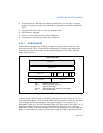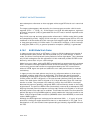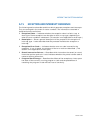
Vol. 3 6-23
INTERRUPT AND EXCEPTION HANDLING
• The stack pointer (SS:RSP) is pushed unconditionally on interrupts. In legacy
modes, this push is conditional and based on a change in current privilege level
(CPL).
• The new SS is set to NULL if there is a change in CPL.
• IRET behavior changes.
• There is a new interrupt stack-switch mechanism.
• The alignment of interrupt stack frame is different.
6.14.1 64-Bit Mode IDT
Interrupt and trap gates are 16 bytes in length to provide a 64-bit offset for the
instruction pointer (RIP). The 64-bit RIP referenced by interrupt-gate descriptors
allows an interrupt service routine to be located anywhere in the linear-address
space. See
Figure 6-7.
In 64-bit mode, the IDT index is formed by scaling the interrupt vector by 16. The
first eight bytes (bytes 7:0) of a 64-bit mode interrupt gate are similar but not iden
-
tical to legacy 32-bit interrupt gates. The type field (bits 11:8 in bytes 7:4) is
described in
Table 3-2. The Interrupt Stack Table (IST) field (bits 4:0 in bytes 7:4) is
used by the stack switching mechanisms described in Section 6.14.5, “Interrupt
Stack Table.” Bytes 11:8 hold the upper 32 bits of the target RIP (interrupt segment
offset) in canonical form. A general-protection exception (#GP) is generated if soft-
Figure 6-7. 64-Bit IDT Gate Descriptors
31
16
15
13
14 12
8
70
P
Offset 31..16
D
P
L
0
4
31
16
15
0
Segment Selector
Offset 15..0
0
TYPE
Interrupt/Trap Gate
DPL
Offset
P
Selector
Descriptor Privilege Level
Offset to procedure entry point
Segment Present flag
Segment Selector for destination code segment
45
0 0 0
31
0
Offset 63..32
8
31
0
12
11
IST
00
2
Reserved
IST
Interrupt Stack Table


















